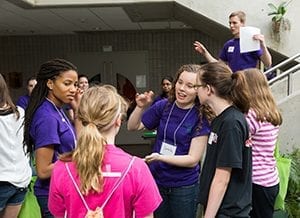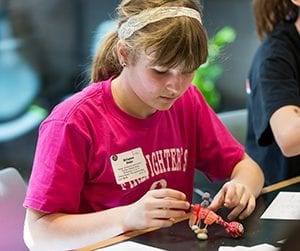News
BTI Hosts “Genetic Freaks” Workshop at Girls’ Science Event

Counting bugs with different characteristics for a “population genetics” snapshot of the candy bug population
A team of BTI and Cornell graduate students, postdocs and researchers put down their pipettes for a day to get girls interested in science careers—using candy and interpretive dance.
In the BTI Atrium, the group quizzed girls on genetics vocabulary, performed a choreographed demonstration of meiosis and constructed candy bug offspring based on the “genes” of parent bugs. Meiosis is a type of cell division that results in sex cells—such as sperm or eggs—that have half of the normal number of chromosomes found in a cell.
The workshop, entitled “Genetic Freaks” was part of Expanding Your Horizons, or EYH, a one-day conference for girls in seventh through ninth grade that engages them in hands-on activities related to science and math. EYH aims to give girls female role models in science and to increase awareness of career opportunities in STEM fields.
Cornell University hosts the event, which features a variety of workshops all over campus. At BTI, the Education and Outreach department gives annual support to BTI’s Postgraduate Society—which provides volunteers for EYH workshops—through program materials, supplies and assistance in developing age-appropriate learning activities.
“The complete workshop is about how meiosis and sex shape diversity in life. So basically, why do you look like your parents, or why you are different?” said Benoit Castandet, a postdoctoral researcher at BTI, who volunteered for the second year in a row.
BTI staff members have participated in EYH for many years now, presenting various workshops including the Genetic Freaks activity. To explain meiosis, the volunteers reenact the movement of chromatids—one half of a duplicated chromosome —and demonstrate how they split during the formation of sperm or egg cells, and later join another chromosome during fertilization.
“It’s a visual representation of how the chromosomes are moving apart and rearranging. It makes it more interesting,” said Coralie Salesse-Smith, a Cornell graduate student in plant biology working with Professor David Stern at BTI, who was participating in EYH for the third time.
Meanwhile, the girls’ parents headed upstairs to talk with BTI Assistant Professor and Research Molecular Biologist at the USDA Agricultural Research Service Michelle Cilia during the morning session. Besides freeing up the girls to explore and ask questions without parental supervision, Cilia’s presentation informed the parents about career opportunities and her own experience working as a scientist.
Once the meiosis demonstration finished, the part that everyone has been waiting for finally begins: the candy bugs.
The girls pair up and analyze the appearance of parent candy bugs—Tootsie Pop tails, gumdrop eyes, gummy worm antennae and chocolate- or yogurt-covered raisins for feet—using a worksheet to figure out what “genes” the bugs carry to give them that appearance. To create their candy offspring, the girls swap half of the parents’ genes with another participant to represent bug mating. After sorting through the baby bugs’ genes, the girls construct their “offspring” using cups full of various candy body parts, which they can take home and eat.
“I knew you were a terrible choice!” joked one participant to her partner, when she was unhappy with the appearance of her bug. “I should have spread around my gene pool a little more!”
Once the bugs were completed, Gregory Booth, a Cornell graduate student in molecular biology and genetics who led the workshop team this year, tallied various bug characteristics such as eye color, tail flavor and the presence or absence of stingers, to give the girls a taste of population genetics—the study of the distribution of different gene types in a population. Even in a room full of candy bugs, just one generation of reproduction shows how mixing genes through sex can increase genetic diversity within a population.
Other workshop volunteers this year included Fabiana Duarte, a Ph.D. student in genetics, genomics and development, and Meera Govindaraghavan, a postdoctoral researcher in molecular biology and genetics.
Amber Hotto, a research associate in the Stern laboratory who helped out with the event, did not attend such events growing up, but wishes she had had the opportunity. “I never knew that anything like this existed when I was a kid,” said Hotto.
Salesse-Smith agreed. “I think it’s a really good opportunity that I wish I’d had.”
BTI members who are interested in helping girls discover the exciting world of science are welcome to volunteer at next year’s EYH event or propose their own workshop to the EYH committee.
“Anyone who has interest can help out if they want to,” said Hotto. “There’s always room.”







